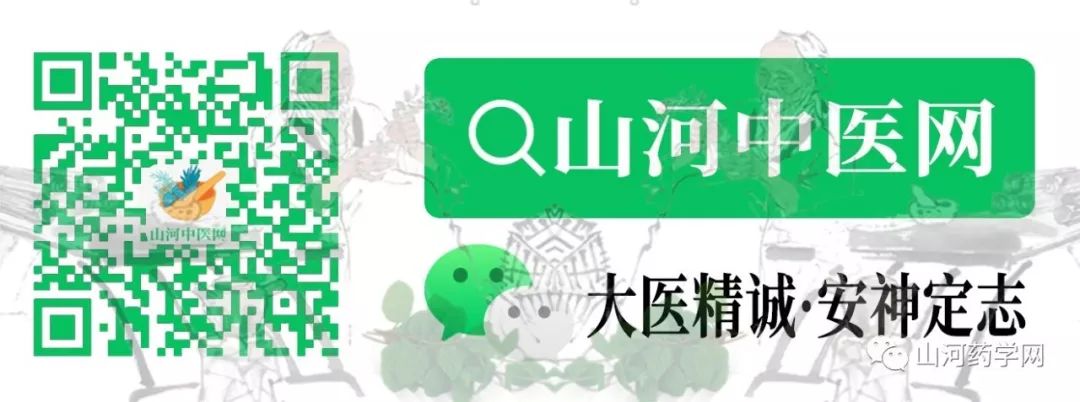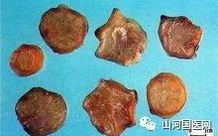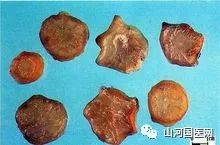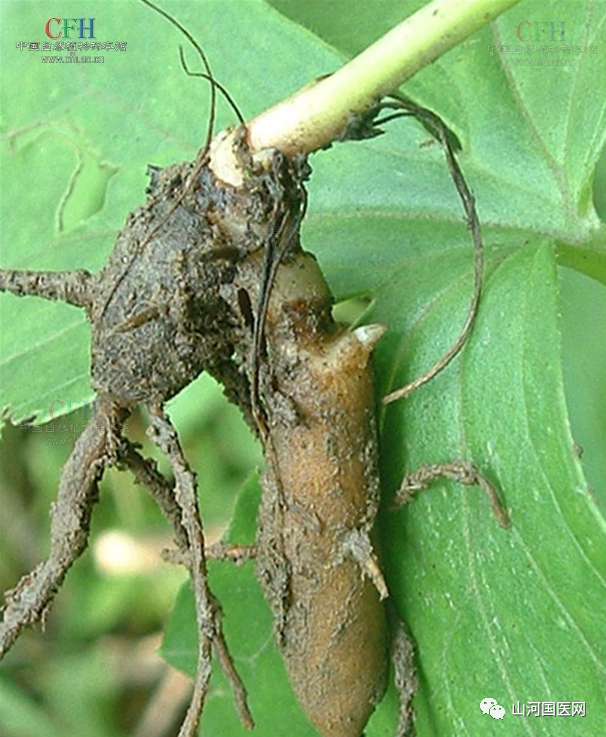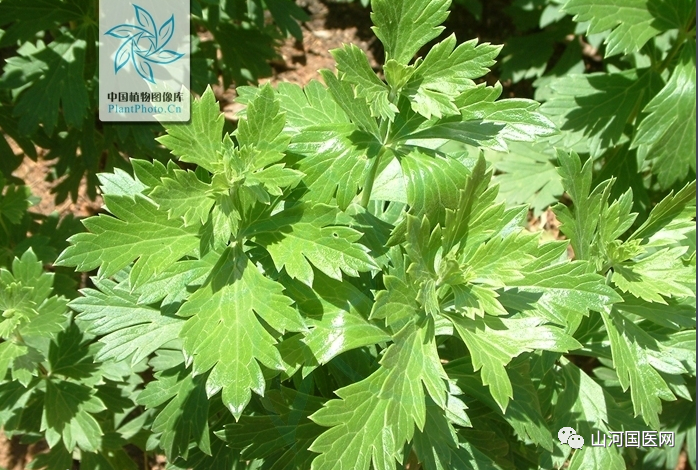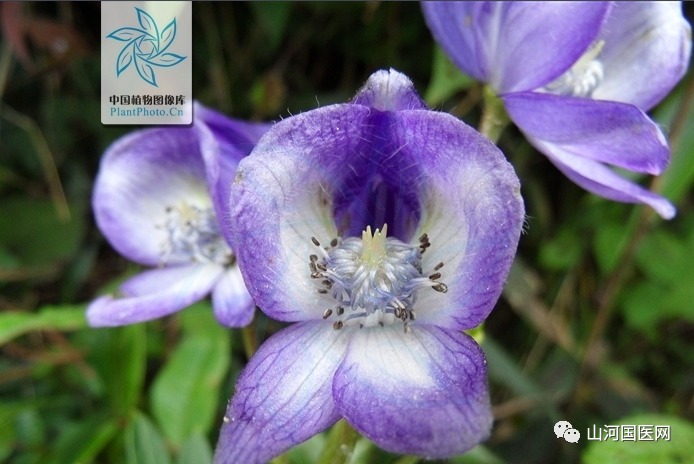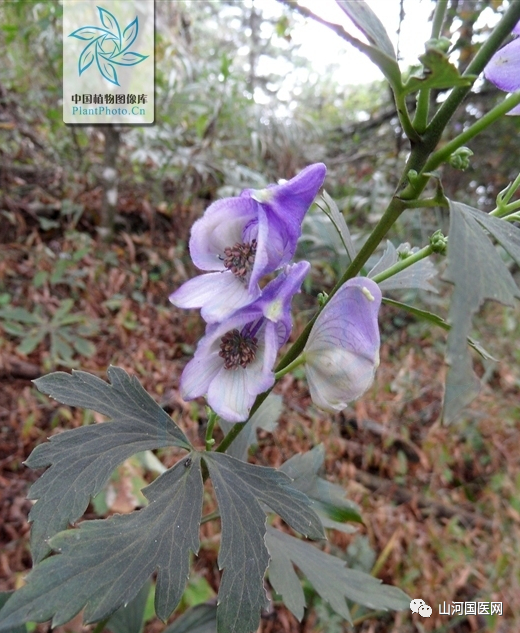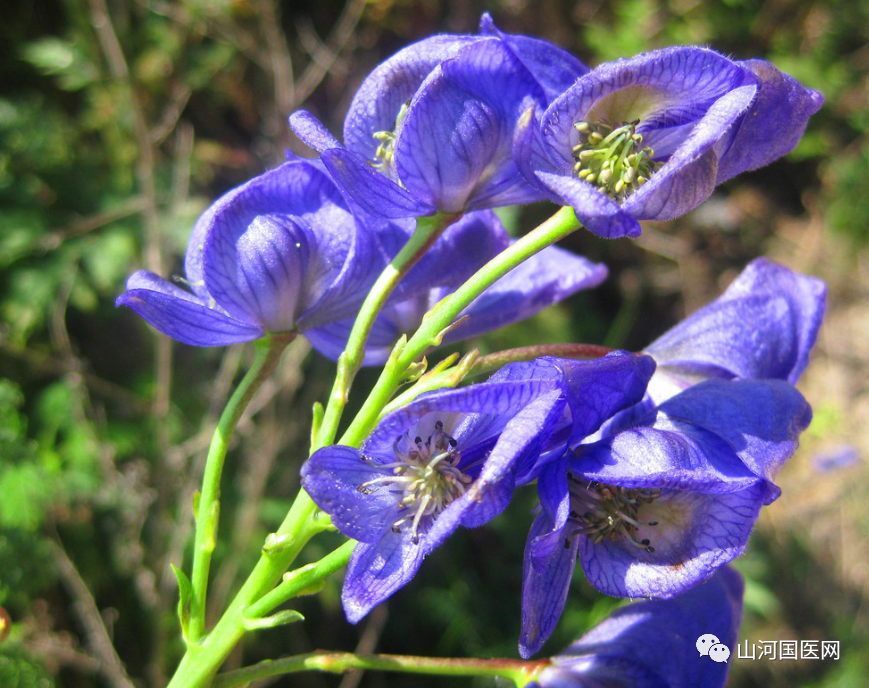
| Fù Zǐ (Aconite) | |
|---|---|
|
Leaves of Aconitum
|
|
| Aliases | Fu Pian, Yan Fu Zi, Hei Shun Pian, Bai Fu Pian |
| Functions | Revives Yang and rescues from collapse, supplements fire and assists Yang, expels wind, cold, and dampness. Used for Yang collapse, cold limbs, weak pulse, impotence, cold in the uterus, cold pain in the heart and abdomen, cold vomiting and diarrhea, water retention due to Yin cold, Yang deficiency with external pathogens, and cold dampness causing pain. |
| First Recorded In | Shen Nong Ben Cao Jing |
| Toxicity | Highly toxic |
| Meridians Entered | Heart, Spleen, Kidney |
| Nature | Hot |
| Taste | Pungent, Sweet |
Fù Zǐ is the tuber of the Ranunculaceae plant Aconitum. It is categorized into “Salted Aconite,” “Black Shun Pian,” and “White Shun Pian” based on processing methods. Its properties are pungent and sweet, very hot; it is toxic. It enters the heart and kidney meridians. Its functions include reviving Yang and rescuing from collapse, supplementing fire and assisting Yang, and alleviating cold pain.Important: The detoxification method for Aconite involves using a large bowl of radish juice, adding five qian each of Huang Lian and Gan Cao, two qian of Xi Jiao, and decocting until reduced to eight parts; this will detoxify the poison.Honey can also detoxify Aconite, but is not suitable for acute poisoning.Roasted Gan Cao and radish decoction are particularly effective in detoxifying Aconite.
Source
This product is processed from the tuber of the plant Aconitum carmichaeli Debx. Harvested from late June to early August, the mother root, fibrous roots, and soil are removed, commonly referred to as “mud Aconite,” and processed into the following varieties.(1) Select large, uniform mud Aconite, wash it, soak it in a solution of edible gallbladder overnight, then add salt and continue soaking, taking it out daily to dry, gradually extending the drying time until a large number of crystalline salt particles (salt frost) appear on the surface of the Aconite, and the texture hardens, commonly referred to as “Salted Aconite.”(2) Take mud Aconite, wash it according to size, soak it in a solution of edible gallbladder for several days, boil it with the soaking liquid until thoroughly cooked, remove it, rinse with water, cut it into slices about 0.5 cm thick, then soak in water, dye the slices with a coloring solution to a dark tea color, steam until an oily surface and gloss appear, then dry or continue drying, commonly referred to as “Black Shun Pian.”(3) Select uniform-sized mud Aconite, wash it, soak it in a solution of edible gallbladder for several days, boil it with the soaking liquid until thoroughly cooked, remove the outer skin, cut it into slices about 0.3 cm thick, soak in water, steam until cooked through, and dry, commonly referred to as “White Shun Pian.”
Preparation Methods
Shun Pian: Black Shun Pian and White Shun Pian can be used directly in medicine.淡附片: Take salted Aconite, soak in clean water, changing the water 2-3 times daily until the salt is completely removed, then boil with Gan Cao and Hei Dou until thoroughly cooked, until there is no numbness when tasted, remove, discard Gan Cao and Hei Dou, cut into thin slices, and dry. For every 100 kg of salted Aconite, use 5 kg of Gan Cao and 10 kg of Hei Dou.炮附片: Take river sand, heat it in a pot, add Aconite slices, stir-fry until puffed and slightly changed in color, then remove and sift out the sand, let cool.
Characteristics
Salted Aconite: Conical shape, 4-7 cm long, 3-5 cm in diameter. Surface gray-black, covered with salt frost, with a depressed bud scar at the top, surrounded by tuberous protrusions or root scars. Heavy body, cross-section gray-brown, with small voids filled with salt frost and polygonal formation layer rings, with irregularly arranged vascular bundles on the inner side of the ring. Slight odor, salty and numbing taste, prickly on the tongue.Black Shun Pian: Longitudinally cut slices, wide at the top and narrow at the bottom, 1.7-5 cm long, 0.9-3 cm wide, 0.2-0.5 cm thick. Outer skin black-brown, cut surface dark yellow, oily and glossy, semi-transparent, with longitudinal vascular bundles. Hard and brittle texture, with a horn-like fracture surface. Slight odor, bland taste.White Shun Pian: Longitudinally cut slices, without outer skin, yellow-white, semi-transparent, about 0.3 cm thick.炮附片: Similar in shape to White Shun Pian, with a deeper color, crumbly texture, slightly puffed.淡附片: Longitudinally cut thin slices, gray-white surface, hard and brittle texture. Slight odor, bland taste, no numbness.Adding “Processed Aconite”: The toxicity of raw Aconite is very high; processed Aconite is made through specific procedures, and its toxicity is significantly reduced. For safety, it is still recommended to decoct first. As for the time, 60 minutes is sufficient.
Identification
Take 4 g of coarse powder from Black Shun Pian or White Shun Pian, add 30 ml of ether and 5 ml of ammonia test solution, shake for 20 minutes, and filter. Place the filtrate in a separating funnel, add 20 ml of 0.25 mol/L sulfuric acid solution, shake to extract, and collect the acid solution. Measure using spectrophotometry (Appendix V A), with maximum absorption at wavelengths of 231 nm and 274 nm.
Nature, Taste, and Meridians
Pungent, sweet, very hot; toxic. Enters the heart, kidney, and spleen meridians.
Main Functions and Indications
Revives Yang and rescues from collapse, supplements fire and assists Yang, disperses cold and alleviates pain. “It is the primary medicine for reviving Yang and rescuing from collapse.” Its efficacy and indications are extensive.Used for Yin excess obstructing Yang, profuse sweating leading to Yang collapse, vomiting and diarrhea with counterflow, cold limbs and weak pulse, cold pain in the heart and abdomen, cold dysentery, edema from foot qi, wind-cold-damp bi syndrome, impotence, cold in the uterus, cold vomiting and diarrhea, water retention due to Yin cold, Yang deficiency with external pathogens, Yin sores and ulcers, and all conditions of persistent cold and stagnation.
Dosage
3-15 g. For reviving Yang and rescuing from collapse, it can be used in doses of 18-30 g. Some cases may use large doses exceeding 30 g.Classic formula: Si Ni Tang: 1 piece of raw Aconite, 1.5 liang of dried ginger, 2 liang of roasted licorice.Breaking the rules to rescue the heart decoction: Aconite 30-100-200 g, dried ginger 60 g, licorice 60 g, Korean ginseng 10-30 g, and 60-120 g of fresh shan yue meat, 30 g each of raw dragon powder and live stone powder.
Precautions
Not suitable for pregnant women. Should not be used with Ban Xia, Gua Lou, Tian Hua Fen, Bei Mu, Bai Lian, Bai Ji. Dosage should be adjusted according to individual conditions; excessive use can be harmful, as Aconite contains toxic components such as aconitine, which primarily stimulates and paralyzes the myocardium, vagus nerve, and peripheral nerves. Symptoms of poisoning may include numbness of the tongue, numbness of limbs, a sensation of ants crawling, dizziness, blurred vision, nausea, vomiting, and in severe cases, life-threatening conditions.
Storage
Salted Aconite should be stored in a sealed container in a cool, dry place; Black Shun Pian and White Shun Pian should be stored in a dry place to prevent moisture.
Notes
(1) This product can easily cause poisoning due to improper processing or excessive dosage. Symptoms of poisoning include burning sensation in the mouth, numbness (starting from the fingers and spreading throughout the body), salivation, nausea, possible vomiting, fatigue, difficulty breathing, dilated pupils, irregular pulse (weak and slow), cold and sticky skin, pale complexion, and possible sudden death. Rescue methods: 1-2% tannic acid for gastric lavage, administer emetics as appropriate; take activated charcoal (mixed with water); intravenous injection of glucose saline. Symptomatic treatment; timely use of stimulants such as nicetamide; maintain warmth; provide oxygen or perform artificial respiration if necessary; if the heartbeat is slow and weak, subcutaneously inject atropine.(2) Boil in water for no less than 1 hour, and no more than 1.5 hours, otherwise, it will affect the efficacy.
Excerpt
Chinese Pharmacopoeia
Origin
Jiangyou in Sichuan is the traditional production area for Aconite. In addition to Jiangyou County (now a city) in Sichuan, there are 336 counties and cities in 10 provinces including Shaanxi, Guizhou, Hunan, Hubei, Gansu, Yunnan, Guangxi, Jiangxi, and Anhui that are suitable for Aconite production, with a total suitable area of 294057.69 km². Using the “Chinese Medicinal Material Production Area Suitability Analysis Geographic Information System (TCMGIS-I),” the nationwide suitable production areas for Aconite were analyzed. The results indicate that according to the climate and soil conditions required for Aconite growth, the production cycle is longer in the cold climate of Butuo County in Liangshan Prefecture, Sichuan, resulting in higher effective component content. Currently, the yield of Butuo Aconite accounts for over 65% of the national total, and in 2008, Butuo Aconite was also recognized as a traditional medicinal material.
Botanical Verification
Aconite was first recorded in the Shen Nong Ben Cao Jing, classified as a lower-grade herb. Tao Hongjing stated: “Aconite and Aconitum share the same root; Aconite is harvested in August… Aconitum is harvested in April, when the stem first grows with a bulbous head, resembling the head of a crow, hence the name ‘bird head.'” Han Baosheng stated: “The correct one is Aconitum, the bifurcated one is Aconitum, and the slender three to four inches one is Tian Xiong; the one with scattered roots like taro is Aconite, and the one with lateral roots is called ‘Cai Zi.’ All five varieties come from the same source but have different names. The seedlings grow about two feet high, with leaves resembling those of Artemisia and Ai.” Su Song stated: “All five varieties now grow in Shu soil, all produced from the same source… their height is about three to four feet, with four-angled stems, leaves like Ai, purple-blue flowers forming spikes, and small black fruits resembling mulberries. Originally, only Aconite was produced, but after maturity, four varieties emerged.” The Ben Cao Gang Mu states: “There are two types of Aconitum; the one from Zhangming is the mother of Aconite, now referred to as Chuan Aconitum, while the one from Jiangzuo Mountain is the Aconitum listed in the classic text, now referred to as Cao Aconitum.”
Clinical Applications
1. Used for counterflow of Yang collapse, weak pulse. If there is profuse sweating, cold limbs, weak pulse, or due to excessive sweating, vomiting, or counterflow, it is often combined with Ren Shen, Gan Jiang, and roasted licorice. If there is profuse sweating and Yang collapse, in addition to Aconite and Ren Shen, it is necessary to add Long Gu, Mu Li, and other astringent herbs to stop sweating; if there is cold limbs and weak pulse after severe bleeding, Aconite, Ren Shen, Long Gu, and Mu Li can be combined with Mai Dong and Wu Wei Zi to revive Yang and rescue Yin.2. Used for kidney Yang deficiency, fear of cold, cold limbs, spleen Yang deficiency, abdominal pain, and loose stools. For all symptoms of kidney Yang deficiency, weak life fire, fear of cold, cold limbs, impotence, and frequent urination, it can be applied, often combined with Rou Gui, Shu Di, Tu Si Zi, and Shan Yao; for symptoms of spleen Yang deficiency, cold pain in the abdomen, and loose stools, it can be combined with Dang Shen, Bai Zhu, Gan Jiang, and roasted licorice.3. Used for wind-cold-damp bi syndrome, pain in the joints and bones. It can be combined with Gui Zhi and other herbs.
Various Discussions
1. Ben Cao Yan Yi: Aconitum, Aconitum, Tian Xiong, Aconite, and Cai Zi are all the same herb, differing only in size and shape. In later generations, for treating deficiency and cold, Aconite must be used, taking care to select those that are flat and large, weighing half a liang or more, as they are the most potent. The wind family often uses Tian Xiong, also selecting the larger ones for their sharp angles and heat properties, thus they are used for dispersing. This is the general use of Aconitum and Aconite. The other three types are used according to their material properties.2. Zhang Yuanshu: Aconite, when used with Bai Zhu, is a holy medicine for eliminating cold and dampness, with less damp herbs added to guide it. It benefits the source of fire to eliminate Yin shadows, thus urination becomes regulated; Aconitum and Aconite are the same.3. Tang Ye Ben Cao: Aconite enters the hand Shao Yang, San Jiao, and Ming Men formulas, floating and sinking, reaching everywhere, with a pungent and very hot taste, being the Yang among Yang, thus it moves and does not stop, unlike Gan Jiang which stops and does not move. It should not be used for those with cold limbs and Yang collapse; it is used for counterflow.4. Zhu Zhenheng: For those with Qi deficiency and severe heat, it is advisable to use Aconite sparingly to promote Ren Shen and Qi; for those who are overweight and damp, it is also advisable to use Aconitum and Aconite sparingly to guide the herbs. The Yan Yi discusses five types of Aconite, all being the same herb, named according to their shape, which is profound but still unclear. Zhang Zhongjing’s Ba Wei Wan uses Aconite as a guide for Shao Yin, with the main supplement being Di Huang; later generations mistakenly regarded Aconite as a tonic. Aconite’s nature is to move and not to stay, but it is used to invigorate Di Huang’s stagnation, which can lead to distant effects.5. Shang Han Yun Yao: Aconite is a key medicine for Yin syndrome, used for all three Yin transformations and cold syndrome with Yin; even if the body is hot and the pulse is deep, it must be used. If there is cold limbs and abdominal pain, with a deep and thin pulse, and severe cases with blue lips and contracted mouth, it must be urgently used, as it has the power to reverse Yin and revive Yang. In recent years, Yin syndrome and cold syndrome are often suspected, and Aconite is not used until Yin is extreme and Yang is exhausted, which is too late. Moreover, in cases of cold syndrome with Yin, both internal and external are Yin, and Yang energy suddenly declines, it is necessary to urgently use Ren Shen to strengthen the pulse and benefit the source, assisted by Aconite to warm the meridians and disperse cold; if not used, how can one save it?6. Yu Tuan: Aconite possesses a strong quality, capable of cutting through barriers and leading Qi tonics to circulate through the twelve meridians, restoring lost Yang; it leads blood tonics into the blood division to nourish insufficient true Yin; it opens pores with dispersing herbs to expel wind and cold from the surface; it warms the lower jiao with warming herbs to eliminate internal cold and dampness.7. Ben Cao Meng Quan: Tian Xiong has a tendency to rise, supplementing Yang deficiency in the upper jiao; Aconite has a tendency to descend, supplementing Yang deficiency in the lower jiao; Aconitum is stable and does not move, residing in the center; Cai Zi has a light and rising quality, suitable for treating wind-cold; Aconitum has a sharp quality, suitable for unblocking meridians and joints, reaching the disease directly.8. Ben Cao Gang Mu: According to the “Wang Shi Jiu Yuan Fang,” Aconite is heavy and stagnant, warming the spleen and expelling cold; Chuan Aconitum is light and dispersing, warming the spleen and eliminating wind; for cold diseases, Aconite should be used; for wind diseases, Chuan Aconitum should be used. It is said that for those with wind stroke, one should not first use wind herbs and Aconitum; if one first uses Qi herbs, then Aconitum is appropriate. Furthermore, when using Aconitum and Aconite, it is advisable to use them cold, as heat can exacerbate cold. Cold in the body leads to floating Yang, and treating it with cold will worsen the condition, while treating it with heat will prevent rejection and allow the disease to improve, thus achieving great benefits; this is the subtlety of reverse treatment. In the past, Zhang Zhongjing treated cold hernia with honey decocted Aconitum; the “Jin Xiao Fang” treated throat obstruction with honey-roasted Aconite; Zhu Danxi treated hernia with Aconitum and Zhi Zi, both using heat to treat cold. Aconitum and Aconite are toxic herbs, not to be used except in critical conditions, but they are commonly used in tonics with small amounts for quick effects. Some people experience unbearable dryness after taking a small amount, while in ancient times, these tonics were used as common herbs; could it be that the climate has changed from ancient to modern times? The Duke of Jingshan, who was thin and cold, had no other illness, and drank Aconite decoction daily, along with chewing sulfur, for several years. Qi Zhou’s Wei Zhang, who took deer antler and Aconite throughout his life, lived to over eighty, healthy and vigorous. These individuals had unique physical constitutions, and their use was beneficial without harm; it cannot be generalized. Furthermore, the “Suo Sui Lu” states that the soil in Huatai is extremely cold, and the people consume Aconite as they would taro or chestnuts; this is due to the earth’s energy.9. Ben Cao Zheng: Aconite, being pungent and very hot, is good at moving, thus it is a key medicine for circulating through the twelve meridians of pure Yang, dispelling surface cold and warming the interior. For true cold, it is effective in treating all three jiao, all organs and bowels, and any true cold can be treated. However, raw Aconite is particularly fierce; if it interacts with Yin, it will drown true Yang. In cases of sudden cold symptoms with cold limbs and clear pulse, or with vomiting and diarrhea, clear and odorless, it is not effective unless raw Aconite is used. For other cold symptoms that can be treated gradually, it is advisable to use processed Aconite, which is gentler. This herb is prone to spoilage, and in the market, it is often sold as a salted product, which, when soaked in water, loses its salty taste, but its pungent and hot properties are still present. Therefore, when using processed Aconite, it is necessary to assist with Gan Jiang, Wu Yu, and others to ensure efficacy, as its true nature has been largely lost. If faced with severe symptoms, it is necessary to use at least one or two qian; otherwise, it may not be effective, and in severe cases, three to five qian should be used, as one cannot act recklessly; this is due to the physical properties of the herb. If raw Aconite is used, or combined with Aconitum or Cao Aconitum, the toxicity is too strong, and one cannot rely on guaranteed success.10. Shen Nong Ben Cao Jing: Used for wind-cold cough and counterflow evil Qi, warming the interior, treating gold wounds, breaking up accumulations, blood stagnation, cold dampness, and relieving knee pain, making it difficult to walk.11. Ming Yi Bie Lu: For cold and weak feet, lumbar and spine wind-cold, cold pain in the heart and abdomen, cholera, and cramping, as well as red and white diarrhea, it strengthens the muscles and bones, and is a top herb for treating all ailments.12. Yi Xue Qi Yuan: “Mainly used to eliminate cold from the organs; supplement Yang Qi deficiency, and warm the spleen and stomach.”13. Wang Haogu: Treats diseases of the governor vessel, with stiffness and counterflow.14. Ben Cao Gang Mu: Treats three Yin cold syndromes, Yin poison cold hernia, cold wind, phlegm counterflow, and Qi counterflow, softening phlegm, epilepsy, slow fright in children, wind-damp paralysis, swelling, and cold feet, headaches, kidney counterflow, and headaches, as well as severe diarrhea, Yang collapse, chronic diarrhea, and cold malaria.15. Ben Cao Bei Yao: Supplements kidney life fire and expels wind-cold-dampness.16. Ben Cao Cong Xin: Treats white turbid, all conditions of persistent cold and stagnation.
Dietary Value
Processed product from the tuber of the herbaceous plant Aconitum. Produced in Sichuan, Hubei, Hunan, and other regions. Harvested in summer and autumn, processed for use. The processed products include salted Aconite, Black Shun Pian, White Shun Pian, and Roasted Aconite, or collectively referred to as processed Aconite.[Properties] Pungent, sweet, hot, and toxic. Can revive Yang and rescue from collapse, warm the kidney and assist Yang, and alleviate cold pain.[References] Contains aconitine, mesaconitine, Chuan Aconitine, and racemic de-methyl aconitine. It has significant cardiotonic effects, with longer boiling times enhancing its cardiotonic effects while reducing toxicity; it has anti-myocardial ischemia and hypoxia effects; it stimulates the pituitary-adrenal cortex system; it has significant anti-inflammatory effects on experimental arthritis, as well as analgesic and sedative effects; it promotes coagulation.[Uses] Used for Yang Qi deficiency leading to collapse, profuse sweating with cold limbs, weak pulse; kidney Yang deficiency, impotence, frequent urination, and cold in the uterus leading to infertility; spleen and kidney Yang deficiency, cold pain in the abdomen, and loose stools; Yang deficiency with edema and difficulty urinating; wind-cold-damp bi syndrome, cold pain in the joints and limbs.[Dosage] 1-15 g per day, preferably decocted for 30 minutes to 1 hour, until there is no numbness or spiciness when tasted. Can be used in porridge or dishes.[Cautions] The toxicity of this product is primarily due to the aconitine it contains, which can cause symptoms such as bradycardia, conduction block, ventricular premature contractions, or tachycardia, and ventricular fibrillation. It is the only toxic herb used in dietary therapy. However, prolonged boiling significantly reduces toxicity, and when used according to guidelines, it is safe and effective. This product can be used for severe conditions such as Yang collapse, but it is not advisable to use it independently.[Additional Formulas] 1. Aconite Porridge: Processed Aconite 10 g, roasted ginger 15 g, and 100 g of japonica rice. Grind the two herbs into a fine powder, use 5 g each time, and cook with japonica rice and water to make porridge. Alternatively, reduce the two herbs by half, decoct to extract the juice, and add to the japonica rice to cook porridge.This formula uses Aconite to warm the interior, disperse cold, and alleviate pain, while roasted ginger warms the middle, disperses cold, and stops diarrhea. It is used for abdominal pain and diarrhea due to internal cold, with loose stools.2. Aconite Lamb Soup: Processed Aconite 25 g, lamb 1000 g. Clean and cut the lamb into pieces, blanch to remove blood, and cook with Aconite in water, adding fresh ginger, scallions, pepper, and salt until the meat is tender. Divide into four servings.This formula uses Aconite to warm the kidney and assist Yang, complemented by lamb to warm and tonify kidney Yang, with fresh ginger and pepper aiding in warming Yang Qi. It is used for Yang deficiency with cold limbs, frequent nighttime urination, or cold pain in the abdomen and waist.If dog meat is used with Aconite to make soup, it has similar functions and uses as this formula.3. Aconite Coix Porridge: Processed Aconite 10 g, coix seed 30 g, and 100 g of japonica rice. Decoction of Aconite to extract the juice, add coix seed and japonica rice, and cook until the porridge is done. Divide into two servings.This formula uses Aconite to disperse cold and alleviate pain, while coix seed eliminates dampness and relaxes the muscles. It is used for wind-cold-damp bi syndrome, joint pain, and limb stiffness.“Indications” 1. Shao Yin cold damage (initially for two to three days, with a weak pulse, but drowsy). Use 2 liang of Ma Huang (remove the nodes), 2 liang of Gan Cao (roasted), and 1 piece of Aconite (processed, skin removed), with 7 sheng of water. First, boil Ma Huang to remove the foam, then add the other two herbs, boil until the juice is reduced to three sheng, and divide into three doses. This is called “Ma Huang Fu Zi Gan Cao Tang.”2. Shao Yin fever (initially for Shao Yin disease, with a counterflow fever and deep pulse). Use 2 liang of Ma Huang (remove the nodes), 1 piece of Aconite (processed, skin removed), and 2 liang of Xi Xin, with 1 dou of water. First, boil Ma Huang to remove the foam, then add the other two herbs, boil until the juice is reduced to three sheng, and divide into three doses. This formula is called “Ma Dian Fu Zi Xi Xin Tang.”3. Shao Yin diarrhea (with clear grains, internal cold and external heat, cold limbs, weak pulse, and no aversion to cold, but a red face, or abdominal pain, or dry vomiting, or throat pain). Use 1 large piece of Aconite (skin removed, cut into slices), 2 liang of Gan Cao (roasted), and 3 liang of dried ginger, with an appropriate amount of water. Boil until reduced to one sheng, divide into two doses and take warm; the pulse will improve. If the face is red, add 9 scallions; if there is abdominal pain, add 2 liang of Bai Shao; if there is dry vomiting, add 2 liang of fresh ginger; if there is throat pain, add 1 liang of Jie Geng; if diarrhea stops but the pulse is weak, add 2 liang of Ren Shen. This formula is called “Mai Si Ni Tang.”4. Yin disease with aversion to cold (after sweating has been induced, but not resolved, and there is aversion to cold, indicating a deficiency). Use 3 liang of Bai Shao, 3 liang of Gan Cao (roasted), and 1 piece of Aconite (processed, skin removed), with 5 sheng of water, boiled down to 1 sheng and 5 ge. Divide into doses. This formula is called “Bai Shao Gan Cao Fu Zi Tang.”5. Yin excess obstructing Yang (the patient is agitated, hot, and drinks water, with a deep pulse and cold limbs). Use 1 large piece of Aconite, burn to a charred state, and grind into powder, taking with honey water. This disperses cold and allows heat to rise, leading to sweating and recovery. This formula is called “Pili San.”6. Wind stroke with phlegm counterflow (unconsciousness, facial drooping). Use raw Chuan Aconitum and raw Aconite, both with skin and navel removed, each half a liang, along with 1 liang of raw Nan Xing and 2.5 qian of raw Mu Xiang. Mix the herbs, take 5 qian, add 10 slices of fresh ginger, and 2 bowls of water, boil down to 1 bowl and take warm. This formula is called “Wu Sheng Yin.”7. Wind disease with paralysis (limbs drooping, facial drooping, slurred speech, unsteady walking). Use Chuan Aconitum (skin and navel removed) and Wu Ling Zhi, each 5 liang, ground into powder, add Long Nao and She Xiang with warm wine to take. Take three times a day. After taking five to seven pills, the hands can move, and the feet can step; after taking ten pills, one can comb their hair. This formula is called “Shen Yan Wu Long Dan.”8. Wind-cold-damp bi syndrome (numbness and lack of sensation, or inability to move limbs). Use fragrant white rice to cook a bowl of porridge, add 4 qian of raw Chuan Aconitum powder, simmer appropriately, add a spoonful of ginger sweat and three large spoons of honey, and take on an empty stomach. Alternatively, add 2 qian of coix powder.9. Wind epilepsy. Use raw Chuan Aconitum (skin removed) 2.5 qian, and 5 Ling Zhi, ground into powder, mix with pig heart blood to form pills the size of a jujube. Take one pill with ginger soup.10. Children’s slow fright (convulsions, phlegm obstruction). Use raw Chuan Aconitum (skin and navel removed) 1 liang, and 10 whole scorpions (tails removed), divided into three doses, each taken with a bowl of water and 7 slices of ginger decoction.11. Children’s fontanel depression. Use Aconitum (raw, skin and navel removed) 2 qian, and Xiong Huang 8 fen, ground into powder. Mix with scallion roots to form a cake and apply to the affected area.12. Edema and pain in the feet. Use one raw Black Aconite (skin and navel removed), ground into powder, mix with fresh ginger juice to form a paste and apply to the swollen area. Reapply until the swelling subsides.13. Chronic headache. Use Chuan Aconitum and Tian Nan Xing, equal parts ground into powder, apply with scallion juice to the temples.14. Persistent tinnitus. Use Aconitum (burned to ash) and Chao Pu, equal parts ground into powder, wrap in cotton and insert into the ear. Change the medicine twice a day.15. Toothache. Use 1 liang of Aconite (burned to ash) and 1 fen of dried alum, ground into powder, and rub on the teeth. Another formula: Chuan Aconitum and Chuan Aconite, raw, mixed into small pills. Each time, take one pill and bite it in the mouth. Another formula: use roasted Aconite powder in the tooth cavity, and the pain will stop.16. Cold pain in the waist. Use deer antler (fur removed, slightly roasted until yellow) and Aconite (processed, skin and navel removed), each 2 liang, with 3 fen of salt flower, ground into powder, and mixed with jujube meat to form pills the size of a jujube. Take thirty pills on an empty stomach with warm wine.17. Cold and heat malaria. Use 1 piece of Aconite weighing five qian, wrap in flour and roast over fire, then remove the flour, add Ren Shen and Dan Sha, each one qian, ground into powder, and mixed with honey to form pills the size of a jujube. Take twenty pills before the onset of illness. If the medicine is effective, there may be symptoms of vomiting or numbness; otherwise, take again the next day.18. Chronic diarrhea. Use two pieces of Chuan Aconitum, one raw and the other boiled with black beans, ground into pills the size of green beans. Take five pills with Huang Lian soup.19. Yang deficiency with hematemesis. Use 1 jin of raw Di Huang, crushed into juice, add a little wine. Additionally, take 1.5 liang of cooked Aconite (skin and navel removed), cut into slices, and place in the Di Huang juice, boil in a stone pot until it becomes a paste, then dry the Aconite slices, grind with 3 liang of Shan Yao into powder, and mix with the paste to form pills the size of a jujube. Take thirty pills on an empty stomach with rice soup.20. White turbid. Use processed Aconite ground into powder. Each dose is 2 qian, add three slices of ginger, and boil with one bowl of water until 60% cooked, then take warm.21. Irregular menstruation. Use processed Aconite (skin removed) and Dang Gui in equal parts. Each dose is 3 qian, boiled in water for consumption.22. Carbuncles and abscesses. Use Chuan Aconitum (stir-fried) and Huang Lian (stir-fried), each 1 liang, ground into powder and mixed with saliva to apply to the affected area. Leave on until dry. If the medicine dries, moisten with rice washing water.23. Boils and swelling. Use vinegar to mix with Aconite powder and apply to the affected area. Reapply until dry.24. Scabies and eczema. Use raw Chuan Aconitum, cut and decoct in water for washing, very effective.25. Cracked hands and feet due to frostbite. Use Aconite (skin removed), ground into powder, mixed with water and flour to apply, effective.Disclaimer:The content of this site is added and organized by users for learning and reference purposes only. The information on the site may not be accurate, comprehensive, or up-to-date, and the content should not be considered the final basis for diagnosing or treating diseases.Shanhe Traditional Chinese Medicine Networkreminds users that if there are any physical discomforts, please seek medical attention promptly. Thank you for your support and love; we will strive to do better~!!!